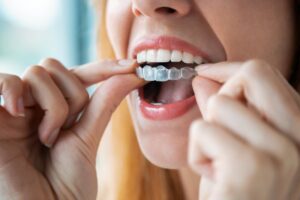
Invisalign has become a popular alternative to traditional metal braces, offering a discreet and convenient way to straighten teeth using clear, removable aligners. While Invisalign is generally safe and effective, it’s important to understand that, like any dental treatment, it can come with potential complications. Knowing these in advance can help you manage expectations and avoid issues during your orthodontic journey.
Discomfort and Soreness
One of the most common side effects of Invisalign is temporary discomfort. As your teeth begin to shift, you may experience soreness or pressure, especially when switching to a new set of aligners. This is a sign that the aligners are working, but it can still be unpleasant for the first few days of each new stage.
Speech Difficulties
Some patients notice a slight lisp when they first begin wearing Invisalign. This typically happens because the aligners slightly alter the shape of your mouth and affect how your tongue moves. For most people, this issue resolves within a few days as they adjust to the aligners.
Dry Mouth or Increased Saliva
Because Invisalign trays cover your teeth entirely, they can cause changes in your saliva flow. Some patients report dry mouth, while others experience excess saliva. Both conditions are usually temporary but can be uncomfortable. Staying hydrated and practicing good oral hygiene can help minimize these effects.
Gum and Soft Tissue Irritation
The edges of Invisalign trays can sometimes rub against the gums, tongue, or inside of the cheeks, causing irritation or sore spots. Dentists can smooth down sharp edges if needed, and wax can also be applied to the trays to provide relief.
Allergic Reactions
Though rare, some individuals may have an allergic reaction to the materials used in Invisalign aligners. Symptoms can include swelling, redness, or itching in the mouth. If you suspect an allergic reaction, it’s important to stop using the aligners and consult your orthodontist immediately.
Tooth Decay and Gum Disease
Because Invisalign trays are worn for 20 to 22 hours a day, any leftover food or plaque trapped under the aligners can lead to tooth decay or gum disease. It’s crucial to brush and floss after every meal and before reinserting the trays. Skipping this step can create an environment for bacteria to thrive.
Compliance-Related Issues
One of the biggest challenges with Invisalign is patient compliance. Unlike braces, which are fixed in place, Invisalign aligners can be removed. This means the treatment only works if you wear them consistently. Not wearing the aligners as prescribed can delay progress and compromise results.
Attachments or Refinements
Many patients require small tooth-colored attachments to help the aligners grip better and move teeth more effectively. While not necessarily a complication, these can make the trays slightly more noticeable. Some patients may also require additional refinements or extra aligner sets, which can extend treatment time.
While Invisalign is a safe and effective treatment for most people, it’s not entirely without risks or complications. Most of these issues are mild, temporary, and manageable with proper care and communication with your orthodontist. Understanding the potential downsides upfront helps you make informed decisions and sets you up for a smoother, more successful Invisalign experience.
About the Practice
If you’re looking for a comfortable alternative to traditional metal braces, look no further! Crossroads Family Dentistry can straighten your smile and improve your oral health with discreet Invisalign clear aligners. Our goal is to make visiting the dentist less stressful, which is why we provide high-quality, friendly, and affordable care for patients of all ages. Ready to transform your smile and life? Call our Forest office at (434) 841-1704 or visit our website to schedule your appointment.
